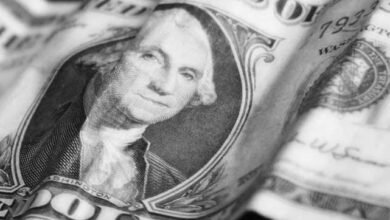Pound Sterling holds above key level as focus shifts to US data

You have reached your limit of 5 free articles for this month.
Don’t miss out on experts’ top articles.
Start your subscription and get access to all our original articles.
Your coupon code
- GBP/USD fluctuates above 1.2800 in the European session on Thursday.
- The pair’s near-term technical outlook highlights sellers’ hesitancy.
- Markets await producer inflation and Retail Sales data from the US.
Following a two-day decline, GBP/USD went into a consolidation phase and closed the day virtually unchanged on Wednesday. The pair holds slightly above 1.2800 in the European session on Thursday ahead of key macroeconomic data releases from the US.
In the absence of fundamental drivers, GBP/USD failed to gather directional momentum midweek. While rising US Treasury bond yields helped the US Dollar (USD) stay resilient against its rivals, the neutral risk mood helped the pair limit its losses.
Pound Sterling price this week
The table below shows the percentage change of Pound Sterling (GBP) against listed major currencies this week. Pound Sterling was the strongest against the Japanese Yen.
| USD | EUR | GBP | CAD | AUD | JPY | NZD | CHF | |
| USD | 0.04% | 0.36% | -0.10% | 0.08% | 0.75% | 0.31% | 0.26% | |
| EUR | -0.04% | 0.32% | -0.15% | 0.03% | 0.71% | 0.28% | 0.22% | |
| GBP | -0.37% | -0.32% | -0.47% | -0.29% | 0.40% | -0.05% | -0.09% | |
| CAD | 0.11% | 0.12% | 0.45% | 0.17% | 0.84% | 0.40% | 0.36% | |
| AUD | -0.08% | -0.04% | 0.28% | -0.19% | 0.68% | 0.24% | 0.17% | |
| JPY | -0.75% | -0.75% | -0.15% | -0.87% | -0.68% | -0.47% | -0.50% | |
| NZD | -0.31% | -0.27% | 0.05% | -0.42% | -0.24% | 0.44% | -0.05% | |
| CHF | -0.27% | -0.23% | 0.10% | -0.37% | -0.19% | 0.47% | 0.04% |
The heat map shows percentage changes of major currencies against each other. The base currency is picked from the left column, while the quote currency is picked from the top row. For example, if you pick the Euro from the left column and move along the horizontal line to the Japanese Yen, the percentage change displayed in the box will represent EUR (base)/JPY (quote).
The US Census Bureau will release Retail Sales data for February later in the session. Investors expect Retail Sales to rise 0.8% following January’s 0.8% decline. A print weaker than analysts’ estimate could weigh on the USD with the immediate reaction.
Investors will also pay close attention to the Producer Price Index (PPI) figures as well. The Core PPI is forecast to rise 0.2% on a monthly basis, down from the 0.5% increase recorded in January. In case this reading comes in above the market expectation, it could be seen as a USD-positive development.
The US economic docket will also feature the weekly Initial Jobless Claims data. It might be difficult to navigate through the US data releases in the second half of the day. The action in Wall Street and bond markets, however, could help the USD find direction.
GBP/USD Technical Analysis
GBP/USD holds above 1.2800, where the mid-point of the ascending regression channel meets the Fibonacci 23.6% retracement of the latest uptrend and the 20-period Simple Moving Average (SMA) on the 4-hour chart. As long as this level stays intact as support, buyers could remain interested. In this scenario, 1.2850 (static level) and 1.2880 (upper limit of the ascending channel, end-point of the uptrend) could be seen as next bullish targets.
On the downside, first support aligns at 1.2770 (50-period SMA) before 1.2750 (Fibonacci 38.2% retracement) and 1.2730 (lower limit of the ascending channel).
Pound Sterling FAQs
The Pound Sterling (GBP) is the oldest currency in the world (886 AD) and the official currency of the United Kingdom. It is the fourth most traded unit for foreign exchange (FX) in the world, accounting for 12% of all transactions, averaging $630 billion a day, according to 2022 data. Its key trading pairs are GBP/USD, aka ‘Cable’, which accounts for 11% of FX, GBP/JPY, or the ‘Dragon’ as it is known by traders (3%), and EUR/GBP (2%). The Pound Sterling is issued by the Bank of England (BoE).
The single most important factor influencing the value of the Pound Sterling is monetary policy decided by the Bank of England. The BoE bases its decisions on whether it has achieved its primary goal of “price stability” – a steady inflation rate of around 2%. Its primary tool for achieving this is the adjustment of interest rates. When inflation is too high, the BoE will try to rein it in by raising interest rates, making it more expensive for people and businesses to access credit. This is generally positive for GBP, as higher interest rates make the UK a more attractive place for global investors to park their money. When inflation falls too low it is a sign economic growth is slowing. In this scenario, the BoE will consider lowering interest rates to cheapen credit so businesses will borrow more to invest in growth-generating projects.
Data releases gauge the health of the economy and can impact the value of the Pound Sterling. Indicators such as GDP, Manufacturing and Services PMIs, and employment can all influence the direction of the GBP. A strong economy is good for Sterling. Not only does it attract more foreign investment but it may encourage the BoE to put up interest rates, which will directly strengthen GBP. Otherwise, if economic data is weak, the Pound Sterling is likely to fall.
Another significant data release for the Pound Sterling is the Trade Balance. This indicator measures the difference between what a country earns from its exports and what it spends on imports over a given period. If a country produces highly sought-after exports, its currency will benefit purely from the extra demand created from foreign buyers seeking to purchase these goods. Therefore, a positive net Trade Balance strengthens a currency and vice versa for a negative balance.
- GBP/USD fluctuates above 1.2800 in the European session on Thursday.
- The pair’s near-term technical outlook highlights sellers’ hesitancy.
- Markets await producer inflation and Retail Sales data from the US.
Following a two-day decline, GBP/USD went into a consolidation phase and closed the day virtually unchanged on Wednesday. The pair holds slightly above 1.2800 in the European session on Thursday ahead of key macroeconomic data releases from the US.
In the absence of fundamental drivers, GBP/USD failed to gather directional momentum midweek. While rising US Treasury bond yields helped the US Dollar (USD) stay resilient against its rivals, the neutral risk mood helped the pair limit its losses.
Pound Sterling price this week
The table below shows the percentage change of Pound Sterling (GBP) against listed major currencies this week. Pound Sterling was the strongest against the Japanese Yen.
| USD | EUR | GBP | CAD | AUD | JPY | NZD | CHF | |
| USD | 0.04% | 0.36% | -0.10% | 0.08% | 0.75% | 0.31% | 0.26% | |
| EUR | -0.04% | 0.32% | -0.15% | 0.03% | 0.71% | 0.28% | 0.22% | |
| GBP | -0.37% | -0.32% | -0.47% | -0.29% | 0.40% | -0.05% | -0.09% | |
| CAD | 0.11% | 0.12% | 0.45% | 0.17% | 0.84% | 0.40% | 0.36% | |
| AUD | -0.08% | -0.04% | 0.28% | -0.19% | 0.68% | 0.24% | 0.17% | |
| JPY | -0.75% | -0.75% | -0.15% | -0.87% | -0.68% | -0.47% | -0.50% | |
| NZD | -0.31% | -0.27% | 0.05% | -0.42% | -0.24% | 0.44% | -0.05% | |
| CHF | -0.27% | -0.23% | 0.10% | -0.37% | -0.19% | 0.47% | 0.04% |
The heat map shows percentage changes of major currencies against each other. The base currency is picked from the left column, while the quote currency is picked from the top row. For example, if you pick the Euro from the left column and move along the horizontal line to the Japanese Yen, the percentage change displayed in the box will represent EUR (base)/JPY (quote).
The US Census Bureau will release Retail Sales data for February later in the session. Investors expect Retail Sales to rise 0.8% following January’s 0.8% decline. A print weaker than analysts’ estimate could weigh on the USD with the immediate reaction.
Investors will also pay close attention to the Producer Price Index (PPI) figures as well. The Core PPI is forecast to rise 0.2% on a monthly basis, down from the 0.5% increase recorded in January. In case this reading comes in above the market expectation, it could be seen as a USD-positive development.
The US economic docket will also feature the weekly Initial Jobless Claims data. It might be difficult to navigate through the US data releases in the second half of the day. The action in Wall Street and bond markets, however, could help the USD find direction.
GBP/USD Technical Analysis
GBP/USD holds above 1.2800, where the mid-point of the ascending regression channel meets the Fibonacci 23.6% retracement of the latest uptrend and the 20-period Simple Moving Average (SMA) on the 4-hour chart. As long as this level stays intact as support, buyers could remain interested. In this scenario, 1.2850 (static level) and 1.2880 (upper limit of the ascending channel, end-point of the uptrend) could be seen as next bullish targets.
On the downside, first support aligns at 1.2770 (50-period SMA) before 1.2750 (Fibonacci 38.2% retracement) and 1.2730 (lower limit of the ascending channel).
Pound Sterling FAQs
The Pound Sterling (GBP) is the oldest currency in the world (886 AD) and the official currency of the United Kingdom. It is the fourth most traded unit for foreign exchange (FX) in the world, accounting for 12% of all transactions, averaging $630 billion a day, according to 2022 data. Its key trading pairs are GBP/USD, aka ‘Cable’, which accounts for 11% of FX, GBP/JPY, or the ‘Dragon’ as it is known by traders (3%), and EUR/GBP (2%). The Pound Sterling is issued by the Bank of England (BoE).
The single most important factor influencing the value of the Pound Sterling is monetary policy decided by the Bank of England. The BoE bases its decisions on whether it has achieved its primary goal of “price stability” – a steady inflation rate of around 2%. Its primary tool for achieving this is the adjustment of interest rates. When inflation is too high, the BoE will try to rein it in by raising interest rates, making it more expensive for people and businesses to access credit. This is generally positive for GBP, as higher interest rates make the UK a more attractive place for global investors to park their money. When inflation falls too low it is a sign economic growth is slowing. In this scenario, the BoE will consider lowering interest rates to cheapen credit so businesses will borrow more to invest in growth-generating projects.
Data releases gauge the health of the economy and can impact the value of the Pound Sterling. Indicators such as GDP, Manufacturing and Services PMIs, and employment can all influence the direction of the GBP. A strong economy is good for Sterling. Not only does it attract more foreign investment but it may encourage the BoE to put up interest rates, which will directly strengthen GBP. Otherwise, if economic data is weak, the Pound Sterling is likely to fall.
Another significant data release for the Pound Sterling is the Trade Balance. This indicator measures the difference between what a country earns from its exports and what it spends on imports over a given period. If a country produces highly sought-after exports, its currency will benefit purely from the extra demand created from foreign buyers seeking to purchase these goods. Therefore, a positive net Trade Balance strengthens a currency and vice versa for a negative balance.
Source link




